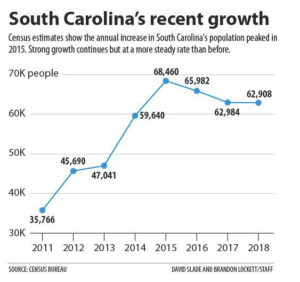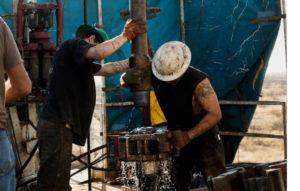#8 Small Metro Nationwide For Millennial Population Growth.
More than 330,000 people now call Spartanburg County home, an increase of more than 15 percent over the past decade. And while data shows that growth is occurring across all demographics and ages, millennials are increasingly discovering our overall quality of life, cost of living, range of career opportunities, and community diversity to be just what they are looking for.
The 8th ranked small metro nationwide for millennial population growth, Spartanburg also recorded a nearly 18 percent increase in the 25-34-year-old population during the past five years. That attraction is fueled by a thriving downtown that boasts a mix of breweries, coffee shops, and restaurants to satisfy every taste, live music nearly every night of the week, an award-winning bookstore and publisher, and an eclectic mix of homegrown retailers and chic boutiques.
 Some of South Carolina’s population growth hot spots have cooled, according to just-released census estimates, but new residents continued to pour in to Horry and Berkeley counties, the counties adjacent to Charlotte, and — perhaps surprisingly — Spartanburg.
Some of South Carolina’s population growth hot spots have cooled, according to just-released census estimates, but new residents continued to pour in to Horry and Berkeley counties, the counties adjacent to Charlotte, and — perhaps surprisingly — Spartanburg.
The Palmetto State has been a fast-growing region for years and that continued through mid-2018. The state added 62,908 residents. More than 80 percent of the growth came from people relocating from other states, the Census Bureau estimated. Continued at postandcourrier.com
 Not long ago, in Spartanburg, S.C., I visited the offices of something called the Spartanburg Academic Movement (SAM). The walls were lined with charts measuring things like kindergarten readiness, third-grade reading scores and postsecondary enrollment.
Not long ago, in Spartanburg, S.C., I visited the offices of something called the Spartanburg Academic Movement (SAM). The walls were lined with charts measuring things like kindergarten readiness, third-grade reading scores and postsecondary enrollment.
Around the table was just about anybody in town who might touch a child’s life. There were school superintendents and principals, but there were also the heads of the Chamber of Commerce and the local United Way, the police chief, a former mayor and the newspaper editor. Continued at nytimes.com
 We are often told that America’s future lies in our big cities. That may no longer be entirely true. Some of the strongest job creation and population growth is now occurring in cities of 1 million people or less.
We are often told that America’s future lies in our big cities. That may no longer be entirely true. Some of the strongest job creation and population growth is now occurring in cities of 1 million people or less.
In this year’s edition of our Best Cities For Jobs survey, we found that six of the 10 metropolitan areas with the fastest job growth are either mid-sized (150,000 to 450,000 total nonfarm jobs) or smaller (less than 150,000 nonfarm jobs). They also account for 18 out of the top 30. Smaller metro areas dominated job growth in a number of sectors, including manufacturing (all the top 20), information (all of the top 10) jobs and, less surprisingly, natural resources, construction and mining. Continued at forbes.com
